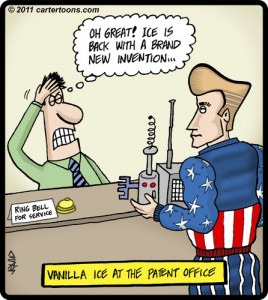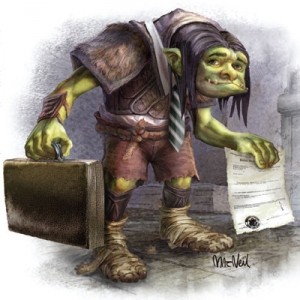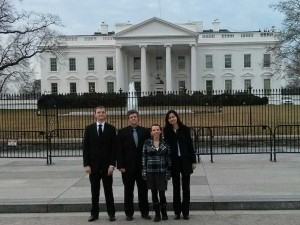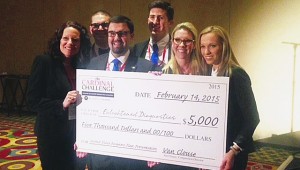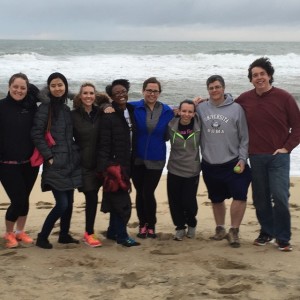A post from our student blogger Roberto
As you likely know by now students in the MSPL have been working long and hard all year on their individual capstone projects. These projects are writing patent applications on various technologies for researchers at Notre Dame. At the conclusion of first semester the students each gave a lengthy presentation to a panel comprised of their inventors, Dr. Deak who is the director of the MSPL, and the representative from the Office of Technology Transfer at Notre Dame who is assigned to their technology. In this first presentation the students worked to explain and demonstrate their understanding of the technology as well as presenting a preliminary set of claims they had forged to protect this technology. This semester, students have worked with professional mentors to perfect their claims and round out many of the sections of the patent application document. This document served as the MSPL thesis and was recently submitted by all the students who intend to graduate this coming May. After submitting their thesis, students also have to give a second presentation to the same panel. This time the students present on the work they did this semester and explain the bulk of the patent application they have crafted. The second presentation wraps up all the work the student has done and allows the Office of Technology Transfer to take the project on from that point.
A few months ago I sat down and looked at my schedule and decided that I was going to take the USPTO patent bar exam at the end of March. At the time, I wrote off the effect of the compounding thesis requirements on top of studying for the bar exam using the PLI review materials. A few short days after turning in my thesis and giving my thesis defense I took and passed the patent bar exam. It was a crazy but extremely rewarding feeling knowing that I had attained my three main academic goals for the semester and that now I could focus on finishing out my year strong and getting ready for my next challenges. The MSPL program put me in a fantastic position to succeed on exam day and prepared me well for the variety of questions that were asked. Our work in the MSPL gave me real life experience that was invaluable and made the entire process much easier. That being said, the MSPL’s focus is not solely on preparing students for the patent bar and therefore it was necessary to fully exploit the wealth of PLI study materials we have access to. After taking many practice tests I was ready to go and hit the ground running.
Now, for the fun part of this post. One thing you probably don’t know about me is that I love cars. When I’m at home it’s hard to find a weekend where I don’t find myself tearing something apart or putting something back together. For example, over Easter break my father and I replaced the radiator on a car and schemed as to the next parts we were going to buy and install. This past week there were some major developments in the auto industry that had intellectual property undertones. First, one of the most acclaimed contemporary automobile designers, Henrik Fisker, has been accused of copying a design of his former employer, Aston Martin. Fisker, who now is a founding partner and executive chairman of Fisker Automobiles, recently debuted a “design study” named the Thunderbolt which shares a striking resemblance to the infamous Aston Martin One-77. Initially, Fisker approached Aston Martin about producing the Thunderbolt and received staunch resistance but he decided to continue on his intended path regardless. Aston has said that after this initial approach, the conversation had left them believing that Fisker would drop the Thunderbolt concept in an effort to avoid any potential issues. That all changed when Fisker himself showed up at the Amelia Island Concours d’Elegance, which is the premier automobile charity event in the world, in the none other but the Thunderbolt. The response from Aston was swift and a legal team soon filed a lawsuit against Fisker in California on multiple counts of trademark infringement. In particular, Aston alleges that the Thunderbolt contains confusingly similar grille and side vent designs compared to its trademarked designs. Most people believe this to be an attempt by the fledgling Fisker to make off with the high class brand and image Aston Martin has worked so hard to establish.
In a strikingly similar case, Bentley finds itself contemplating potential legal action after the 2016 Lincoln Continental concept was unveiled at the New York auto show. Much like the Aston-Fisker case, Bentley is upset because Lincoln is attempting to unfairly profit from the brand image Bentley has worked hard to attain. As you can see from the images, several key aspects of the Bentley are present in the Lincoln and serve to confuse the buyer as to the product they are actually viewing. By most estimates, the 2016 Lincoln Continental, should it become a production car, would retail in the $60,000 range which is only a fraction of the over $200,000 base price of the 2014 Bentley Flying Spur. Perhaps the most fascinating aspect of this case is the reaction of Bentley head designer Luc Donckerwolke (who is also the man responsible for the stunning Lamborghini Murciélago) who said; “Somebody asked me if I wanted to sue. I said, ‘No! I don’t want to sue. I don’t care about that. My issue is about respect for the car-design process.’ If we start copying each other, then this is a negative for the design culture.” In today’s global rip-off culture it is refreshing to hear such a prominent figure speaking out against acts which are all too often considered common place. It will be interesting to see how Bentley proceeds and if they take notes during the pending legal case between Aston Martin and Fisker. It is often said that imitation is the sincerest form of flattery but I’d be willing to bet that recent events have left Bentley and Aston Martin less than impressed.


